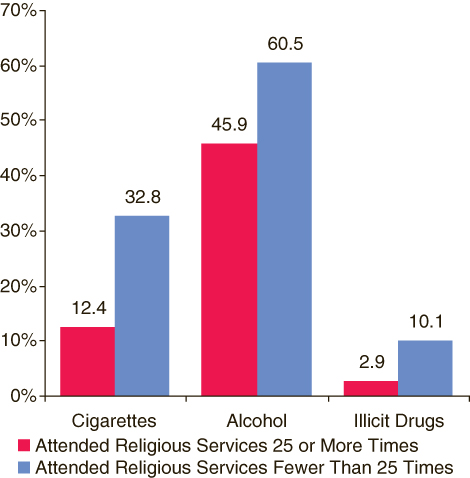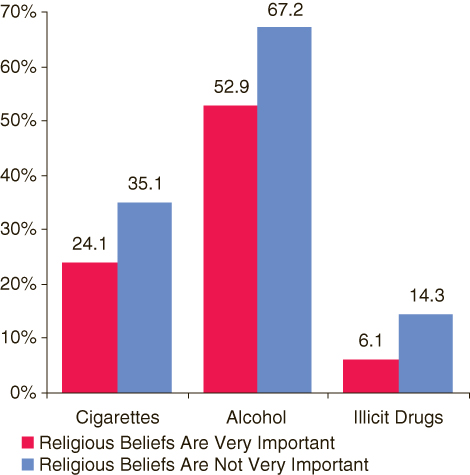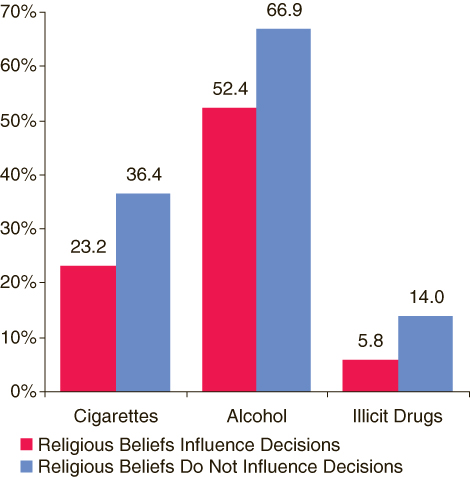 |
| March 23, 2007 |
Religious Involvement and Substance Use among Adults
In Brief
- In 2005, 30.8 percent of adults aged 18 or older attended religious services 25 or more times in the past year, 78.1 percent reported that religious beliefs are a very important part of their lives, and 75.1 percent reported that religious beliefs influence how they make decisions in their lives
- In 2005, 2.9 percent of adults who attended religious services 25 or more times in the past year used illicit drugs in the past month compared with 10.1 percent of those who attended religious services fewer than 25 times
- Adults who reported that religious beliefs are a very important part of their lives were less likely to use illicit drugs in the past month than those who reported that religious beliefs are not a very important part of their lives (6.1 vs. 14.3 percent)
|
Public opinion polling has shown that 63 percent of Americans were members of a church or synagogue in 2006.1 Religiosity has been identified in other research as an important protective factor against substance use.2-4 The National Survey on Drug Use and Health (NSDUH) includes questions on religious service attendance and religious beliefs. Respondents are asked to indicate how many times in the past 12 months they attended religious services, excluding special occasions such as weddings, funerals, or other special events. Respondents also are asked whether their religious beliefs are a very important part of their lives and whether their religious beliefs influence how they make decisions in their lives.5 NSDUH also includes questions about use of cigarettes, alcohol, and illicit drugs during the month (or 30 days) prior to the interview. Illicit drugs refer to marijuana/hashish, cocaine (including crack), inhalants, hallucinogens, heroin, or prescription-type drugs used nonmedically.6
This report examines the relationships between religious service attendance and beliefs and substance use among adults aged 18 or older. All findings are based on data from the 2005 NSDUH.
Religious Involvement among Adults
In 2005, 30.8 percent of adults aged 18 or older (an estimated 67 million persons) attended religious services 25 or more times in the past year, 78.1 percent (168 million persons) reported that religious beliefs are a very important part of their lives, and 75.1 percent (162 million persons) reported that religious beliefs influence how they make decisions in their lives.
Females were more likely than males to report all three types of religious involvement (Table 1). The percentages of adults reporting that their religious beliefs are a very important part of their lives and the percentage reporting that religious beliefs influence how they make decisions increased with each age category. For example, 70.6 percent of young adults aged 18 to 25 reported that religious beliefs are a very important part of their lives compared with 83.7 percent of older adults aged 65 or older. Adults aged 65 or older were more likely to attend religious services 25 times or more in the past year than adults in all other age groups.
Table 1. Percentages and Standard Errors of Adults Aged 18 or Older Reporting Religious Involvement, by Age Group and Gender: 2005
Age Group/
Gender |
Attended
Religious
Services 25 or
More Times in
the Past Year |
Religious
Beliefs Are
a Very
Important
Part of Their
Lives* |
Religious
Beliefs
Influence How
They Make
Decisions in
Their Lives* |
| Percent |
SE** |
Percent |
SE |
Percent |
SE |
| Total |
30.8 |
0.42 |
78.1 |
0.32 |
75.1 |
0.34 |
| Age |
|
|
|
|
|
|
| 18-25 |
21.6 |
0.43 |
70.6 |
0.44 |
63.5 |
0.45 |
| 26-34 |
22.6 |
0.74 |
75.8 |
0.69 |
70.0 |
0.75 |
| 35-64 |
32.3 |
0.61 |
79.1 |
0.47 |
77.2 |
0.48 |
| 65+ |
42.8 |
1.32 |
83.7 |
1.01 |
83.7 |
1.02 |
| Gender |
|
|
|
|
|
|
| Male |
26.1 |
0.54 |
74.1 |
0.48 |
70.5 |
0.51 |
| Female |
35.2 |
0.54 |
81.8 |
0.40 |
79.2 |
0.42 |
| Source: SAMHSA, 2005 NSDUH. |
Religious Service Attendance and Substance Use
In 2005, adults aged 18 or older who attended religious services 25 or more times in the past year were less likely to have used cigarettes, alcohol, or illicit drugs in the past month than adults who attended religious services fewer than 25 times in the past year (Figure 1). For example, 2.9 percent of adults who attended religious services 25 or more times in the past year used illicit drugs in the past month compared with 10.1 percent of adults who attended religious services fewer than 25 times in the past year.
Figure 1. Percentages of Adults Aged 18 or Older Reporting Past Month Substance Use, by Past Year Religious Service Attendance: 2005
 |
Figure 1 Table. Percentages of Adults Aged 18 or Older Reporting Past Month Substance Use, by Past Year Religious Service Attendance: 2005
| Substance |
Attended Religious Services 25 or More Times |
Attended Religious Services Fewer Than 25 Times |
| Cigarettes |
12.4 |
32.8 |
| Alcohol |
45.9 |
60.5 |
| Illicit Drugs |
2.9 |
10.1 |
| Source: SAMHSA, 2005 NSDUH. |
Importance of Religious Beliefs and Substance Use
Adults aged 18 or older who reported in 2005 that religious beliefs are a very important part of their lives were less likely to have used cigarettes, alcohol, or illicit drugs in the past month than adults who reported that religious beliefs are not a very important part of their lives (Figure 2). For example, 6.1 percent of adults who reported that religious beliefs are a very important part of their lives used illicit drugs in the past month compared with 14.3 percent of adults who reported that religious beliefs are not a very important part of their lives.
Figure 2. Percentages of Adults Aged 18 or Older Reporting Past Month Substance Use, by Whether or Not Religious Beliefs Are a Very Important Part of Their Lives*: 2005
 |
Figure 2 Table. Percentages of Adults Aged 18 or Older Reporting Past Month Substance Use, by Whether or Not Religious Beliefs Are a Very Important Part of Their Lives*: 2005
| Substance |
Religious Beliefs Are Very Important |
Religious Beliefs Are Not Very Important |
| Cigarettes |
24.1 |
35.1 |
| Alcohol |
52.9 |
67.2 |
| Illicit Drugs |
6.1 |
14.3 |
| Source: SAMHSA, 2005 NSDUH. |
Religious Beliefs' Influence on Decisions and Substance Use
Adults aged 18 or older who reported in 2005 that religious beliefs influence how they make decisions in their lives also were less likely to have used cigarettes, alcohol, or illicit drugs in the past month than adults who reported that religious beliefs do not influence how they make decisions (Figure 3). For example, 5.8 percent of adults who reported that religious beliefs influence how they make decisions in their lives used illicit drugs in the past month compared with 14.0 percent of adults who reported that religious beliefs do not influence how they make decisions.
Figure 3. Percentages of Adults Aged 18 or Older Reporting Past Month Substance Use, by Whether or Not Religious Beliefs Influence How They Make Decisions in Their Lives*: 2005
 |
Figure 3 Table. Percentages of Adults Aged 18 or Older Reporting Past Month Substance Use, by Whether or Not Religious Beliefs Influence How They Make Decisions in Their Lives*: 2005
| Substance |
Religious Beliefs Influence Decisions |
Religious Beliefs Do Not Influence Decisions |
| Cigarettes |
23.2 |
36.4 |
| Alcohol |
52.4 |
66.9 |
| Illicit Drugs |
5.8 |
14.0 |
| Source: SAMHSA, 2005 NSDUH. |
End Notes
1 The Gallup Organization. (2007). Religion. Retrieved January 31, 2007, from http://www.galluppoll.com/content/?ci=1690&pg=2
2 National Center on Addiction and Substance Abuse at Columbia University. (2001, November). So help me God: Substance abuse, religion and spirituality. New York: Author. [Available as a PDF at http://www.casacolumbia.org/supportcasa/item.asp?cID=12&PID=127]
3 Wallace, J. M., Myers, V. L., & Osai, E. R. (2004). Faith matters: Race/ethnicity, religion and substance use. Baltimore, MD: The Annie E. Casey Foundation. [Available as a PDF at http://www.aecf.org/publications/browse.php?filter=21 and http://www.aecf.org/publications/data/1_04_585_faith_matters_report.pdf]
4 Kendler, K. S., Gardner, C. O., & Prescott, C. A. (1997). Religion, psychopathology, and substance use and abuse: A multimeasure, genetic-epidemiologic study. American Journal of Psychiatry, 154, 322-329.
5 Response options for both questions were (1) strongly disagree, (2) disagree, (3) agree, and (4) strongly agree. For this report, responses of agree/strongly agree were grouped into the "yes" category, and responses of strongly disagree/disagree responses were grouped into the "no" category.
6 NSDUH measures the nonmedical use of prescription-type pain relievers, sedatives, stimulants, or tranquilizers. Nonmedical use is defined as the use of prescription-type drugs not prescribed for the respondent by a physician or used only for the experience or feeling they caused. Nonmedical use of any prescription-type pain reliever, sedative, stimulant, or tranquilizer does not include over-the-counter drugs. Nonmedical use of stimulants includes methamphetamine use.
Figure and Table Notes
* Respondents are asked whether their religious beliefs are a very important part of their lives and whether their religious beliefs influence how they make decisions in their lives. Response options for both questions were (1) strongly disagree, (2) disagree, (3) agree, and (4) strongly agree. For this report, responses of agree/strongly agree were grouped into the "yes" category, and responses of strongly disagree/disagree responses were grouped into the "no" category. Adults with unknown or missing data were excluded from the analysis.
** SE = Standard Error.
Suggested Citation
Substance Abuse and Mental Health Services Administration, Office of Applied Studies. (March 23, 2007). The NSDUH Report: Religious Involvement and Substance Use among Adults. Rockville, MD.
The National Survey on Drug Use and Health (NSDUH) is an annual survey sponsored by the Substance Abuse and Mental Health Services Administration (SAMHSA). Prior to 2002, this survey was called the National Household Survey on Drug Abuse (NHSDA). The 2005 data are based on information obtained from 45,774 persons aged 18 or older. The survey collects data by administering questionnaires to a representative sample of the population through face-to-face interviews at their place of residence.
The NSDUH Report is prepared by the Office of Applied Studies (OAS), SAMHSA, and by RTI International in Research Triangle Park, North Carolina. (RTI International is a trade name of Research Triangle Institute.)
Information on NSDUH used in compiling data for this issue is available in the following publication:
Office of Applied Studies. (2006). Results from the 2005 National Survey on Drug Use and Health: National findings (DHHS Publication No. SMA 06-4194, NSDUH Series H-30). Rockville, MD: Substance Abuse and Mental Health Services Administration.
Also available online: http://www.oas.samhsa.gov.
Because of improvements and modifications to the 2002 NSDUH, estimates from the 2002 to 2005 surveys should not be compared with estimates from the 2001 or earlier versions of the survey to examine changes over time.
|
(formerly The NHSDA Report) is published periodically by the Office of Applied Studies, Substance Abuse and Mental Health Services Administration (SAMHSA). All material appearing in this report is in the public domain and may be reproduced or copied without permission from SAMHSA. Additional copies of this report or other reports from the Office of Applied Studies are available online: http://www.oas.samhsa.gov. Citation of the source is appreciated. For questions about this report, please e-mail: shortreports@samhsa.hhs.gov.
|

This page was last updated on July 11, 2008. |





